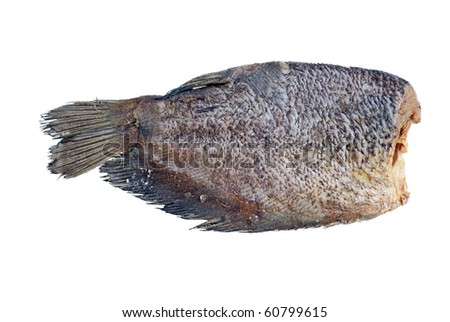The Case of the Headless Fish
Thai Common name Pla Salit, Plat Salit
If Sean Connery pronounces it Flatt Shawl-lit
Food Name Thai Smoked Salted Gourami
Latin Name of the Fish Trichogaster pectoralis
Common Name Snake Skin Gourami, Ikan Spart
Okay, let’s face it… Sean would never eat this stuff… it does not taste like smoked salmon or herring. It will never be in his genes to put this into his mouth. What the heck is this stuff, anyway?
When I was a young baddie laddie, I always thought this was a local salted fish. After all, I used to catch a lot of this fishes in the monsoon drains or longkangs and kept them as pets (Okay, this longkang thingie would be another story later…). I had no idea that it is smoked, only that it had a unique salty flavor to it and was a great condiment for half-boiled eggs, hot steamed rice, congees and durians. Yes Madams and Sirs, place a generous flake of the cooked Flatt Shawl-lit on top of a glorious stinky ripe meaty durian and many durian lovers will swear… it’s just better than sex.
The dried Pla Salit is usually sold as shown above in Asian supply shops. The strong, pungent smell can be overwhelming to those not used to dried-salted fishes and seafood. Store in air-tight anti-rust containers or bags in a cool, dark place.
Trichogaster pectoralis or the freshwater Snakeskin Gourami is a fairly large and common anabantoid fish found in Asia, especially in rice growing regions such as Thailand, Cambodia and Malaysia. It favors shallow, slow flowing bodies of water with abundant aquatic plant life. An anabantoid fish that belongs to the labyrinth group of fishes with a unique body organ called the labyrinth chamber, it allows them to extract oxygen directly from atmospheric air.
The Snakeskin Gourami can grow up to 26cm or 10 inches and the male fishes build huge bubble nests during spawning. In Thailand, gourami fries are released into the rice fields after the rice seedlings have been planted and the fields are purposely flooded for a few months until harvesting time. The Snakeskin Gourami which is an omnivorous fish, helps to control filamentous algae which would choke the fields and compete with the rice plants for nutrients if uncontrolled. The fishes also regulate insect and aquatic snail population which would otherwise destroy the rice plants.
In a period of three to four months, the fish would grow to a length of 17-20cm/ 7-8 inches in favorable conditions. About this time, the rice harvest is at hand and the fields are drained and a bonus after the rice is harvested, are the now adult gouramis.
The fishes are collected, beheaded and gutted before heavily salted in successive layers on bamboo trays and stored for weeks under shade. Then, they are placed in kilns and smoked for several hours using dried oily, coconut shells as the smoking media before removed to cool and packed for sale.
To prepare this fish for cooking, clean the Pla Salit by removing the scales and giving it a good rinse in clean, running water. Allow the fish to air-dry for half an hour before frying in hot oil between 220˚C-260˚C until the fish is golden brown and crispy. Nice! It is at its best when it is hot and crispy. It has got a salty, slightly earthy and smoky flavor.
Another way to enjoy it is to add a generous layer of thinly sliced red shallots, sliced red chili as much as you dare, chopped Chinese Parsley, basil or mint, sprinkle a teaspoon of fine castor sugar and squeeze a few ripe calamansi limes onto it; the senses will just be joyfully overwhelming… salty, sweet, sour, spicy, smoky, crispy, herby and stinging from the shallots. What a culinary experience a humble freshwater fish can give.
Fresh Calamansi Limes for sale at an Asian market.
They are also known as Acid Oranges or Limau Kasturi in Malay
They are also known as Acid Oranges or Limau Kasturi in Malay
The frying of this fish is best done in an open-air space. If you are cooking this salted fish near Sean’s neighborhood or in other parts of Europe, kindly forewarn your neighbors a year ahead or invest in an industry-grade air filter system in your kitchen like the ones below. Otherwise a team of environmental officers in bio-hazard suits will be visiting you within the hour to investigate bio-terrorism complaints.
Multiple exhaust vents at an industrial complex, Asia.
To pacify the environment officers, invite them in for a cuppa tea with a wee dram of milk and generous wedges of England’s best Blue Stilton Cheese and crackers. On the positive side, you’ll be best mates with your Asian neighbors if you happen to have durians too. Cheers.



No comments:
Post a Comment